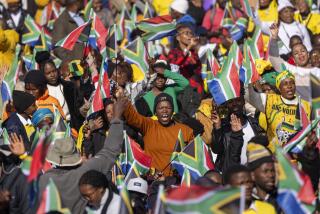South Africa Benefits in Fomenting Black-on-Black Violence
- Share via
JOHANNESBURG — South Africa’s news blockade means that Americans no longer regularly see pictures of white authorities battling blacks here. Instead, the images are all of so-called black-on-black violence, the latest of which is the riot-devastated Crossroads.
Lingering close to the surface of the collective unconscious of the international community is the even more grisly image of an anonymous black youth, a burning tire (“necklace”) around his neck, being dragged by an angry mob to his fiery death.
As a result, while there is still a very deep disgust for apartheid throughout the world, there is also a growing if hesitant sense of uncertainty. “Look how barbaric the black South Africans are,” some people seem to be saying. “Are they really able to govern themselves?”
The apartheid government and its cautious supporters worldwide are clearly the beneficiaries of such questions. They ask them most loudly, most frequently and in such a way that suggests that, as far as they are concerned, the answers are self-evident.
But nothing in South Africa is self-evident, least of all the events that matter most--those that are unfolding in the black townships where rioting has become a revolution.
What is going on there is not simply black-on-black violence, as the government asserts, nor is it merely the blood-lust of infantile masses bent on chaos and destruction.
At the moment, in at least 45 urban areas and as many rural districts, two deadly wars are being waged.
One is the war of the state against the youths who have been driven by white intransigence and brutality to fight to the bitter end.
The other is the war between different groups or organizations opposed to apartheid, which are fighting for control of the rioting youths--for ownership of the revolution.
Once again it is the white state that reaps most of the spoils. Still, the overwhelming majority of the roughly 400 blacks who have died at the hands of other blacks have been either town council members, policemen or police informers. In the real political picture the deaths of these people, known in the townships as “sellouts,” are casualties suffered by the white state.
The practical effect of their deaths on the balance of power in the townships has been overwhelming. Most surviving black representatives of white authority have fled the townships, neutralizing the once-extensive spy network of the security police and in turn making it much easier for an anti-apartheid group to mobilize mass support.
The white state has had to fall back on a second line of defense. At the same time that its army has occupied at least three dozen black townships, the state has done its utmost to foment violence between rival political groups such as the United Democratic Front and the Azanian People’s Organization, which are vying for unchallenged leadership of black South Africans.
The state has also played its part in the emergence of bloody right-wing black vigilante groups. It is misleading to suggest that the government security apparatus is directly responsible for the formation of all vigilante groups that have recently popped up around the country. Yet if it was possible to examine the origins of all of these violent, generally reactionary bands, there is little doubt that active government participation would be regularly uncovered.
As far as the real political picture is concerned, the vigilante groups are of much greater assistance to the government than the government is to them.
No longer able to infiltrate the townships, and having failed to suppress the 21-month-old revolt, the white state has chosen to devote all of its energies to keeping the revolt confined to black areas. And in those areas it has given up all hope of restoring law and order.
Instead, it has chosen to ignore the lawlessness and violence of the black groups whose ideological inclinations do not threaten the existing order. State security forces, for example, have not prevented town councilors and other reactionary elements from forming their own mini-armies, and have done nothing to stop them from murdering the black youths who are actively involved in the national uprising.
As for the white state’s own violence--more devastating than all the other violence combined, thanks to its firepower and its ruthlessness--this is reserved for the masses. And the masses, mainly young people between the ages of 8 and 28 who are armed for the most part only with stones or petrol bombs, continue with an astuteness that their leaders seem to have lost. While those leaders fight more and more among themselves, these youths direct their anger and their violence at the system that oppresses them, and at the people--both black and white--who defend it.
More to Read
Sign up for Essential California
The most important California stories and recommendations in your inbox every morning.
You may occasionally receive promotional content from the Los Angeles Times.













